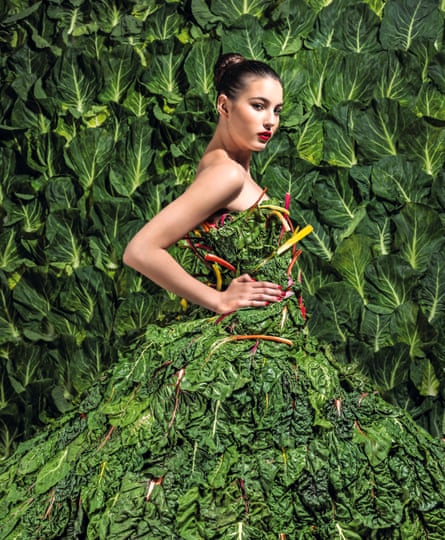
Nestled among stuffy interior decorating and antique shops, Daylesford farmshop and cafe in Pimlico is, judging by the queue on a weekday mid-afternoon, very much the chic place to meet for a fresh vegetable juice (£6) or a superfood salad (£14). A decade ago, you’d have struggled to find a place such as this in London; now, there seems to be one opening every other day. But, as one review warns, everyone at Daylesford “is likely to be thinner, blonder and richer than you”, and I can testify that this much is true. It is part of a chain owned by Carole Bamford, a woman described on her website as “a visionary in organic farming and healthy food retailing”. She is also the wife of Anthony Bamford, director of the JCB construction empire, although here in the farm shop the emphasis is very much on organic spelt bread rather than hydraulic excavators.
The Guardian’s product and service reviews are independent and are in no way influenced by any advertiser or commercial initiative. We will earn a commission from the retailer if you buy something through an affiliate link. Learn more.
I have come to Daylesford to have a green juice with Calgary Avansino, whose chosen career would have seemed similarly far-fetched a decade ago. I first met Avansino years ago when she worked at Vogue as editor Alexandra Shulman’s assistant. At the time, she struck me as polite, pretty and a tiny bit scary, like everyone who works for Vogue. Today, she beams with the kind of good health you’d expect of someone who blogs about how to make chia seed pudding. Writing last year about “healthy fixes for the Christmas feast”, she urged readers to offer guests “an avocado and cacao mousse” instead of mince pies. “Your friends and your body will thank you,” she promised, strongly suggesting she has never met any of my friends. Her book on wellbeing, Keep It Real, will be published next year.
Despite having had her third child four months ago at the age of 40, Avansino is very slim. This is not really a surprise: in a recent blog, she detailed her typical weekly diet, which included lunches of avocado on broccoli bread (“My new favourite thing!”) and green smoothies for breakfast. She frequently advises against gluten and describes herself as “not crazy about wheat”. She also writes about how to feed kids healthily. For instance, “Don’t think you have to start your kids eating with bananas – start with a courgette or sweet potato, which is much better than a high glycemic banana.”
“I’ve never had any training, and I’m not a chef,” Avansino says when I ask about her nutritional qualifications. “I’ve just always eaten like this, and it comes from a very honest and easy place.”
When Avansino moved to London from the US with her husband 14 years ago, people thought her “a total weirdo” for eating quinoa. Today, she says, everyone else is catching on: “I read this great article recently about how where you get your juice now is more important than what label you wear, because it’s sort of like discreet one-upmanship. I think it’s all positive.”
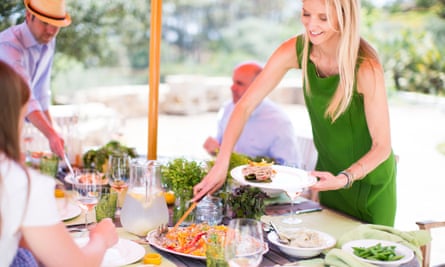
As anyone who has endured a million Instagram photos of avocado on gluten-free bread (“#avotoast!!!”) knows, Avansino is right: ostentatiously ascetic good health is now a major fashion trend. “Wellness”, as style.com recently put it, using the zeitgeisty term for the pursuit of health, is “the new luxury status symbol… If five years ago it was a Céline bag, today’s ultimate status symbol might just be a SoulCycle hoodie and a green juice.” While such breathless prose might make you want to throw a spiralizer through a window (for the uninitiated, that’s a machine that turns vegetables into vague substitutes for spaghetti, thus sparing you those dreaded carbs), it is true that the pursuit of “wellness” hits that crucial point on the Venn diagram between aspiration, self-love and slimness. It’s the ultimate modern sweet spot, especially because you don’t even have to admit that you’re trying to lose weight (so boring, so unfashionable). You are simply pursuing “wellness”.
Within the last decade, being a wellness blogger – someone who writes on nutrition and counsels others on how to change their diet – has overtaken fashion stylist and yoga teacher as the fashionable job option for young women. When Gwyneth Paltrow, whose nutritional qualification is nothing more than a lifetime of eating, launched goop.com in 2008, promoting such untempting sounding propositions as the “21-day elimination diet”, she was roundly mocked. But she is having the last laugh. Other female celebrities – Jessica Alba and Blake Lively, for instance – have since launched their own wellness websites, and it was recently announced that Paltrow is creating a range of organic gluten-free ready meals featuring options such as kale ravioli. Even Pippa Middleton is reportedly training to be a nutritionist, surely the ultimate sign that the trend has hit the mainstream.
Instead of qualifications in boring things such as nutrition and science, the wellness guru has a blog and an Instagram account. From these, she advises thousands, even millions, of followers in her friendly, informal tone to avoid the likes of tropical fruits (too high in sugar) and stock up instead on cold-pressed green juices. She makes dark references to the many ways in which today’s food industry is making us all sick. She also includes many, many photos of herself to confirm the efficacy of her recommendations.
The wellness blogger is, crucially, photogenic and young, which is why “wellness” looks so much more desirable than it did a decade ago, when it was Gillian McKeith, say, telling us all to eat more fibre. Eat like me, look like me, is the message. Typical photo poses include sitting on a beach lounger in a bikini while drinking from a coconut, or reclining in a rustic kitchen in skinny jeans, a cute porcelain bowl of vegetables in one hand. There are differences, however: some bloggers endorse juice fasts, whereas others scorn juice and compare its sugar content to Coca-Cola; some promote fasting, others advise against. Such subjective disagreements are perhaps inevitable among a profession in which no training is required.
It’s easy to mock this phenomenon, but it is big business now. Wellness gurus accrue lucrative endorsements from healthfood brands, exercise equipment makers and spas, which they promote on their blogs. Publishers cannot give them book deals fast enough, and bestseller lists in the UK, Australia and US are filled with volumes on wellness, which mix recipes with vague nutritional advice and, of course, many, many photos.
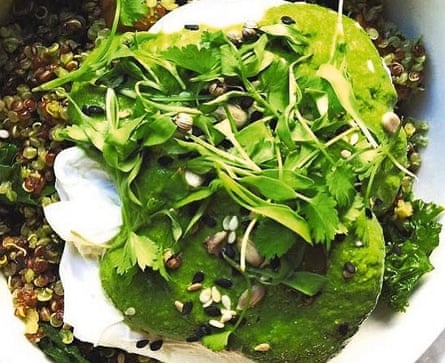
It’s perhaps not surprising that these books have found such a large audience: most people do eat too much crap and would like to be healthier, or at least thinner. If it takes a bunch of 25-year-olds with access to social media to make eating fruit (non-tropical) seem cool, this can only be a positive thing, surely? The emphasis on the alleged nefariousness of wheat and gluten feels more trendy than true, but if some people unnecessarily cut out bread and eat more vegetables, well, that doesn’t sound like the worst trade-off in the world.
But food bloggers and nutritionists, unlike dietitians, are not regulated, and a few problems have emerged in this wellness gold rush. Until earlier this year, Belle Gibson was a very successful blogger in Australia. Her claims that she had cured herself of various cancers through eating fruit and vegetables brought her enormous attention. She is estimated to have made more than $1m from her app, The Whole Pantry, and the book of the same name, which was published by Penguin. Apple was planning to include her app on its Apple Watch. She boasted that she had encouraged “countless others” who suffered from cancer to reject conventional medical treatment and opt instead to treat themselves naturally.
In April, it was revealed that Gibson’s story was bogus: she never had cancer. She gave a tearful interview to Women’s Weekly magazine in which the journalist drily reported, “She says she is passionate about avoiding gluten, dairy and coffee, but doesn’t really understand how cancer works.” Penguin said it had published the book “in good faith” and had never sought to verify Gibson’s claims.
Over in the US, wellness blogger Vani Hari, aka the Food Babe, is one of the most popular writers on nutrition and has successfully lobbied food brands such as Kraft to remove various chemicals from their products (scientists have argued that such campaigns were unnecessary). A former financial consultant, with no nutritional or science training, Hari’s blog now reaches well over a million followers and features posts with the kind of attention-grabbing headlines bloggers are so good at, such as “3 Things Doctors Say You Should Do… But Shouldn’t!” and “Are You Eating This Ingredient Banned All Over the World?” Hari has been widely condemned by scientists and dietitians, who say that she “exploits the scientific ignorance of her followers”. She has also been described as “the Jenny McCarthy of food” (the actor McCarthy, similarly unversed in science, encouraged Americans not to vaccinate their children, warning it would cause autism). Hari has responded by quoting Gandhi – “First they ignore you, then they laugh at you, then they fight you, then you win” – and suggesting her critics are in the pay of big pharma and food corporations, thus making a virtue of her outsider status and lack of nutritional training.
The pursuit of ‘wellness’ hits that crucial point on the Venn diagram between aspiration, self-love and slimness
I grew up in New York and have spent time in Los Angeles. Along with Sydney, these are probably the epicentres for kooky, healthy eating trends, and I have watched many come and go. Although trendy British cafes serve gluten-free muffins and soya latte these days, I assumed that most Brits were too sardonic to go too far down this path.
I was wrong. Over the past year, wacky nutritional advice has been increasingly creeping into the national press, all in the name of “wellness”. One regular (and self-confessedly wholly unqualified) nutritional newspaper columnist frequently insists that gluten-free options are inherently healthier, which, according to the British Dietetic Association, is simply untrue for the vast majority of people. In April this year, an uncritical profile of the Australian wellness blogger and “photogenic fruitarian” Freelee the Banana Girl reported that “Freelee pioneered the Raw Till 4 regime, whereby she eats nothing but uncooked fruit until 4pm — sometimes dozens of bananas a day — allowing herself some grains, a little fat from nuts and seeds and a huge plate of steamed green or starchy vegetables in the evening”. Freelee credits this regime, we were solemnly informed, “with curing her eating disorder”.
Then there are the British wellness bloggers, who are increasingly hard to avoid: Ella Woodward, Tess Ward, Madeleine Shaw, the Hemsley sisters and Calgary Avansino. It isn’t hard to see the appeal for their many fans: the prettier, posher and thinner they are, the more success they enjoy. When Ella Woodward published her book Deliciously Ella earlier this year, her publishers reprinted it six times before it was even released, to keep up with demand; it became the fastest-selling debut cookbook of all time. (Twenty-four-year-old Woodward is the daughter of Shaun Woodward, the former Northern Ireland secretary, and Camilla Sainsbury of the supermarket family.)
Another British wellness book, Get The Glow, by 25-year-old “nutritional health coach” Madeleine Shaw (147,000 followers on Instagram), became a number one bestseller last month. I asked her editor, Anna Valentine at Orion, how she accounts for such rapid success. “This is a crowded area of the market, and each book has to shout to be heard,” she says. “A strong platform and engaged audience is crucial to help cut through the noise.”
“In the long term, I’d like to see Madeleine as a female Jamie Oliver,” adds Shaw’s manager, Alice Russell. Russell has arranged sponsorship deals for Shaw from companies including Brita water filters and Savse smoothies. “We look at what’s a good fit for Madeleine. We’ve turned down a lot of money in the past from companies, so she can be built in the right way.”
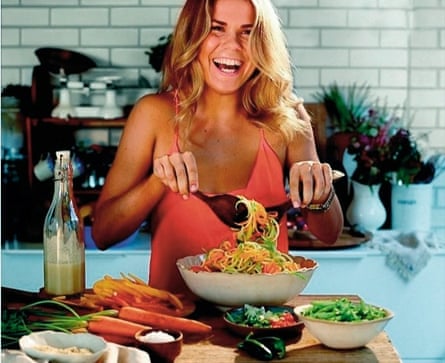
Shaw herself is more than aware of where the appeal lies. “Some of the girls, like the Hemsleys and Ella, are very pretty, but I think it’s that we’re all so nice and smiley and approachable,” says Shaw, who is all of those things. Like many books by wellness bloggers, Get The Glow mixes perfectly sensible if hardly novel advice (eat less sugar) with less well-founded claims (wheat, Shaw writes, “is like sandpaper for the gut”). The recipes, too, are an even split between the healthy but tempting (Thai beef salad) and the healthy but not (pizza with a crust made of mashed cauliflower bound together with egg white).
Shaw and I meet in the newly opened South Kensington Club (all the new nutritionists seem to be based in south-west London: my week of interviewing them involves trekking around the golden triangle of Sloane Square, South Kensington and Notting Hill), and she talks engagingly about how she, like nearly all British wellness bloggers, became interested in healthy eating after suffering from digestive problems. She describes herself as “a modern-day hunter-gatherer. I think we got it right at the beginning and things have become more processed, and I think that’s causing problems for so many people,” she says with the uptick accent so popular now in certain areas of Britain.
Yet people are living a lot longer than they were 500 years ago, I say.
“I totally get your point,” Shaw concedes, “and I think it’s because our medicines have developed and we’re not running around with sticks and getting eaten by animals and stuff like that. But we’re not as connected with our bodies as we used to be – we eat out of boredom or, like, convenience, or, like, to stay awake to get stuff done. So it’s about getting in touch with your food to see where it’s from.”
She advises against wheat very strongly, but people did eat wheat 500 years ago, didn’t they?
“I think it’s because of the way it’s done now,” she says. “If it was wheat that was grown a long time ago, it was really nutritious, it had long roots, it had some goodness. But now it’s more of a dwarf crop and it doesn’t have the same nutrition.” Shaw thinks everyone should give up wheat, “just to see how they feel”. She is currently doing a three-year course at the London-based College of Naturopathic Medicine.
Very few wellness bloggers have traditional nutritional qualifications, such as university degrees. At most, some have taken the year-long, $5,995 online course from the New York-based Institute for Integrative Nutrition (IIN), which, while licensed by the New York state education department, only qualifies students to describe themselves as an “integrative nutrition health coach”. They can use this qualification all around the world. (Pippa Middleton is said to be taking the IIN course as I write.)
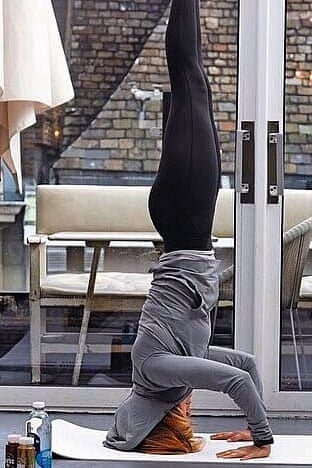
The IIN was founded by Joshua Rosenthal, whose nutritional background is, spokesperson Justine Thorner explains, “a master of science degree in education and 30 years of experience in health, wellness, wholefoods, personal coaching and teaching”. (In other words, he learned to be a teacher in nutrition by teaching about nutrition.) He still teaches 50% of the programme, alongside visiting teachers – “the best in the world,” according to Rosenthal – who include such zeitgeisty figures as Huffington Post editor-in-chief Arianna Huffington and Dr Mehmet Oz. Oz, an American heart surgeon with his own TV show, has been regularly criticised by fellow doctors, who recently described him as “routinely [showing] disdain for science and for evidence-based medicine”. As for Oz’s coverage of weight-loss supplements, Senator Claire McCaskill told him in a senate hearing last year, “You are melding news and entertainment in a way that harms consumers.”
I ask Thorner if the IIN has any concerns about the controversy surrounding its visiting teacher. “Dr Oz’s lecture focuses around simple tips for health and happiness,” she says. “Criticism surrounding other aspects of his work unrelated to IIN will not impact our relationship with him.” To be fair to the IIN, New York’s Columbia University still employs Oz, too, much to the dismay of some of his colleagues. “A health coach does not diagnose, treat or take responsibility for bringing about wellness changes in a client’s life,” Thorner says. “Rather, he or she guides and supports the development of and progress towards personal wellness goals. The UK is one of the top countries that we have students from.”
When I ask Anna Valentine at Orion if she is concerned about commissioning a book about healthy eating from someone without traditional nutritional qualifications, she replies, “Madeleine [Shaw] is a trained nutritional health coach from the Institute of Integrative Nutrition. She learned to cook and gained lots of practical experience in healthfood cafes and restaurants. She was also employed to cook for a professional rugby team.”
The publishers of these wellness books may not demand real nutritional expertise, but sometimes the gaps in the bloggers’ knowledge show. In one recent exchange on her blog, which gets 2.5m hits a month, Woodward was asked by a commenter why she doesn’t use millet in her recipes: “I don’t use millet as it contains gluten and all my recipes are gluten-free. Hope you love the recipes! X,” she explained in her characteristically chatty style.
Her loyal followers pointed out that millet does not, in fact, contain gluten. Woodward, undaunted, simply moved the goalposts: “I prefer to stay away from millet as I personally find it difficult to digest. Have a nice day! X,” she replied.
It isn’t true that nutrition advice changes all the time. But people want to hear stuff that is different, sexy and new
To be fair, few wellness bloggers claim to be experts. “I always say I haven’t had training, and I never get into the science because that’s not my strength,” Avansino tells me. Even so, Paul McArdle of the British Dietetic Association takes a fairly dim view of this kind of thing. “Personal experience in making a dietary change in your own life is not a qualification to advise others about nutrition,” he says. “The word nutritionist has no legal meaning – anyone can call themselves a nutritionist, and if you are a member of the public, you have no protection from rogue advice. People say that health advice changes all the time, but that isn’t true – we’ve been saying the same things for years. But people want to hear stuff that is different, sexy and new.”
One of these different, sexy and new things is the move against wheat and gluten. “We have noticed a rise in people claiming they have an intolerance to wheat and gluten, but the figures are in actuality very, very low,” McArdle says.
I ask about Shaw’s contention that the root of the problem is in the way wheat is farmed these days. He gives this short shrift: “There is some evidence that there are strains of wheat that cause a reaction in those who have a sensitivity, and older-fashioned strains of wheat can be better for those who have a sensitivity. But the numbers are still very low.”
Is it not sensible to advise those with digestive troubles to cut down on wheat, then? McArdle gives an exasperated sigh: “A nutritionist should not advise someone with digestive problems to cut out wheat – they don’t have medical training and there may be other issues. People often don’t realise that what I call ‘nutrition lite’ people aren’t qualified to diagnose anything. So they’ll take advice from them and not see professionals.”
Tess Ward and I meet in a restaurant in Notting Hill. With her cute blond bob and an accent that could cut glass, she is so pretty that our waiter nearly trips over his own feet. She is also very thin. “I am thinner than I normally am, because I just discovered I’ve got a food allergy,” she tells me. “I am trying my darnedest right now to put on weight with protein shakes!” She grins.

Ward’s followers (26,400 on Instagram) make frequent envious comments about her physical appearance. Does she think her looks play a part in her appeal? “I find that a difficult question to answer. I never mediate my [Instagram] images. It’s more, ‘Oh, I’m wearing nice shoes and here’s a juice on the floor.’ Because then maybe someone will think, ‘Oh, yes, maybe I’ll have a juice.’ ”
Her new book, The Naked Diet, focuses, she says, “on stripping ingredients back to their bare essentials, but in no way is it about dieting”. Unusually for a wellness blogger, Ward has had professional training in cookery, studying at Le Cordon Bleu. But, like Shaw, her nutritional training came from the IIN and, also like Shaw, she was inspired to study there after suffering from digestive problems that were never fully diagnosed.
“I personally can’t digest wheat,” Ward tells me. “I wouldn’t recommend everyone cut it out, but there’s loads of research saying spelt is good for people with IBS and fighting bowel cancer.” (When I ask McArdle about Ward’s claim, he says, “You can find studies to support any theory you want, but most are not robust enough to count as medical research.”)
The IIN claims that more than 68,000 people have completed its year-long online course in being a health coach. Intrigued, I enrol on the introductory session, also online, opting to join a Sunday evening class (there are only 100 students per class, and many are already booked up).

Sharon, the tutor, speaks to us directly in the pre-recorded seminar, illustrating the IIN’s friendly, wide-eyed, all-inclusive attitude to nutrition with photos and video clips. The year-long syllabus includes talks on all manner of eating plans, such as the Atkins diet, and cleanses, no matter how medically dubious: “One of the fundamental teachings of the school is a concept Joshua [Rosenthal] coined as bio-individuality, meaning one person’s food is another person’s poison,” spokesperson Thorner explains. “Given this unique standpoint, we do not value any one diet over another.” There is a repeated emphasis on the importance of all-over health, and how graduates will have “the confidence to go out there and convert people”. Alongside this wholesome, holistic approach are repeated reminders of how much an IIN graduate can earn: “We’ll show you how to be a six-figure health coach even with a full-time job,” is one of Sharon’s opening remarks, and this kind of thing is repeated frequently. Most people who come into the programme, she says, “have no training in nutrition”. Nonetheless, “halfway through the course you will have the confidence to take on clients. Many students make back their tuition [fees] before graduation.”
So could I start taking on clients and charging them after just six months, I ask Thorner.
“We recommend our students be upfront with their clients about where they are in their programme and charge a lower rate while in school, for example around $95 a month,” she says. “After graduation, our coaches can feel confident in charging a higher rate, such as $195 a month.”
I don’t sign up for the rest of the course, but the IIN does its best to convince me otherwise, sending daily emails. A typical one comes with the subject line “Are you already a Health Coach without knowing it?” There is a link to a video in which Sharon explains that there is “a huge demand for a new kind of professional - a health coach [because] traditional doctors don’t necessarily have the time or resources to help their patients build healthy habits and change their lifestyle”.
There is no denying that how we eat is important, and the rise of nutritionists is testament to public awareness of that, even if a large part of their appeal is the whispered promise of thinness. And a lot of what these bloggers advocate – less sugar, more vegetables – is perfectly sensible. But it is often served up with a hefty side dish of misinformation and encouragement of food phobias. After all, being obsessive about healthy eating isn’t actually all that healthy.
I suspect that, in a small way, these women know this, and realise that public enthusiasm for them will eventually wane, as it does with all fashion trends. Several bloggers who declined to be interviewed for this piece did so because they “don’t want to be seen as part of that group”, and several of those who did speak to me made the same point. “I really think of myself as more of a chef and food writer than a blogger or nutritionist,” Tess Ward says, twice. She then shows me her Instagram page, proving that she doesn’t follow “many of them”, favouring instead chefs such as Skye Gyngell and Angela Hartnett. She looks up from her phone suddenly, as if a thought has just occurred to her: “You know, you should talk to some chefs. They really know amazing things about food.”
- Main image, styling by Andie Redman. Hair and makeup by Camilla Hewitt at Frank Agency using Mac Cosmetics and Bumble and bumble.
Comments (…)
Sign in or create your Guardian account to join the discussion